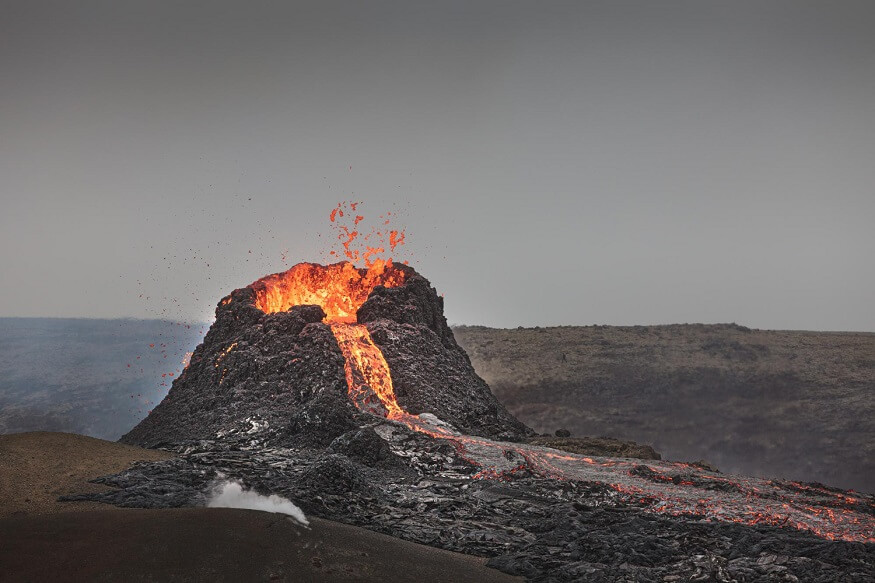The earth is alive!! Not alive like human beings, but the Earth is always moving and changing and never stays the same and you may see it right before your eyes or you may not even see yet feel it at all. The earth is changing right now beneath our feet. One of the most beautiful yet terrifying changes that occur is called a Volcanic eruption.
What are Volcanoes?
Volcanoes are places where volcanic eruptions occur. It is a fracture or an opening in the Earth’s crust, from where hot lava or magma erupts out to the earth’s atmosphere. Deep inside the earth’s crust are vast chambers of molten liquid rock also called magma. Magma contains trapped gases which can feed a volcano and rises to the surface of the earth. Volcanic lava consists of molten rock, hot rock pieces and hot gaseous elements. Lava is erupted out of explosive and non-explosive volcanoes. These mountains are formed through thousands of years of small and spaced eruptions, the sediments of the magma overlapping over the years and forming mountains.
Which types of volcanoes are there?
Active volcanoes are those volcanoes which can erupt at any moment and can pose a danger at any point in time. They are volcanoes that are currently erupting or erupt frequently. Most of the volcanoes of the earth fall under this category.
Dormant volcanoes are those which are sleeping and have been asleep for a long time but may erupt any time. They can suddenly without any symptom or warning can become active. Dormant volcanoes are potentially active. Sometimes people mistake these as extinct volcanoes and establish settlements around the volcano. But when these dormant ones become active, they can engulf or destroy the whole settlement around it.
Extinct volcanoes are those which were once active but are not currently erupting. Volcanologists with help of study declared that these volcanoes will no longer be erupting in the future.
What are the types of Volcanic Eruptions?
There are mainly two types of volcanic eruptions which are,
Central type of volcanic eruption where volcanic eruption takes place through a single vent in the earth’s crust. This type of volcano occurs with an explosion. This type of volcano is usually in a conical shape like a tall mountain-like structure.
Fissure type volcanic eruption takes place without any explosion or explosive activity. Not all volcanoes have cone-like structure, and not all volcanoes come out of mountains. They might not even have any type of vent or crater in the earth’s crust. It is mostly structured as a fracture or crack in the earth’s crust.
Also Read: 10 Activities for Kids to Learn Geography
Which are the active and dormant volcanoes in India?
There are 8 volcanoes in India, below you will find the list of volcanoes in India in the present day.
Baratang Island: located in Andaman Islands, is a Mud Volcano. It is one of the active volcanoes in India presently and it is approximately 1,745 ft. It is the only mud volcano in India. Mud volcanoes are a bit different from typical or usual volcanoes. Instead of molten rock, it is driven by hot water and natural gas.
Barren Island: it is located in Andaman Islands, ranging 1181 ft. It is one of the active volcanoes in India. It is a type of stratovolcano, which means that it is formed due to layers and layers of lava and ash. It is built up due to frequent eruptions and is one of the most prominent volcanoes in India. Barren Island last erupted in 2021 making it an active volcano in India.
Deccan Traps: located in Maharashtra. This volcanic province is an extinct volcano in India. It stands at a whopping range of 11,483 ft. Igneous province or volcanic province is a large collection of volcanic mountains. It is more like a fissure type volcanic area; it is formed when the lava travels through a long way on the earth’s crust. Scientists believe that Deccan traps may have played a role in the extinction of the dinosaurs.
Dhinodhar Hills: it is an extinct volcano in India located in Gujarat. This volcano hill stands at 1,288 ft tall. Volcanic hill is a cone shaped hill, it is built up as a result of piled up volcanic eruptions throughout the time. It is layered up at the vent or crater on the earth’s crust.
Dhosi Hill: it is located in Haryana which is an extinct volcano in India. Dhosi Hill is also a type of Volcano hill. It also contains a crater and stands at a range of 2,428ft.
Narcondam Island: it is located in the Andaman Islands. It is a dormant volcano in India. It stands tall at 2,329 ft. It is also a type of stratovolcano.
Tosham Hill: it is an extinct volcano located in Haryana. It is at a high range of 679 ft. it is also a type of volcanic hill.
Loktak lake: it is situated at Manipur and is approximately 2,520 ft. tall. Loktak lake is an extinct volcano in India. It is a caldera which means that it is a huge crater which is formed due to a large eruption which might have caused the tip of the volcano to collapse or fall in.
These are the most prominent volcanoes in India. In our country we have 2 active volcanoes and 5 extinct volcanoes. To talk about dormant, we just have one dormant volcano in India.
Also Read: Facts About Asia
What are the benefits of volcanoes?
Volcanoes produce fertile soil. A certain while after a volcanic eruption, the magma containing molten rock, dust and gaseous elements decomposes and becomes soil. Due to different weather changes the magma or volcanic particles become fertile soil.
Geothermal energy can be produced with the help of young and active volcanoes.
Most of the metals such as Lead, Zinc, Copper and Gold are associated with magma. Magma that erupts from inside the earth’s crust usually contains different types of metals. Even precious metals.
Due to volcanic eruption most of earth’s water is released into the atmosphere in the form of water vapor.
The magma or lava contains igneous rocks, which make up 80% of the Earth’s surface. These beautiful rocks can be found in the sediments after a volcanic eruption, as the lava mainly consists of them.
Hot springs support local wildlife habitats. Many of the hot springs that emerged after a volcanic eruption can be used as geothermal energy for heat and power.
Volcanoes have the capability to create or bring up or form land through their eruptions. “The Hawaiian Islands are one of the most important examples of land formation after an eruption.
Years ago, the Earth’s atmosphere was composed mainly of silicate vapor. During early ages, volcanic carbon dioxide and water vapor were released into the Earth’s atmosphere, which mixed and reacted to form the Earth’s aerobic atmosphere.
EuroSchool is a platform to educate and cultivate geographic knowledge in kids. Enrol your child with EuroSchool today!











